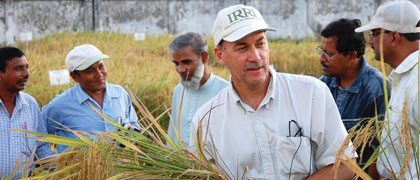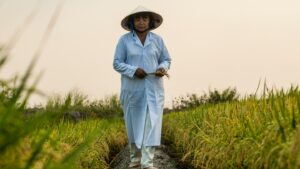Dealing with Too Little or Too Much Water
Breeding tolerance to abiotic stresses of drought and flooding was the theme of this year’s joint meeting of the National Association of Plant Breeders and the Plant Breeding Coordinating Committee.
Drought, flooding and other extreme global weather events appear to be on the rise, which has researchers working to breed tolerance for water stress into plants.
This very topic was the theme of the 2014 joint meeting of the National Association of Plant Breeders and the Plant Breeding Coordinating Committee, which was held in Minneapolis, Minnesota, in early August.
The conference featured presentations on breeding tolerance to water stress from international experts, including B.M. Prasanna, director of the Global Maize Program at the International Maize and Wheat Improvement Center (CIMMYT), and David Mackill, a plant science manager at Mars Inc. and an adjunct professor in plant sciences at the University of California, Davis.
Based in Kenya, Prasanna talked about breeding drought-tolerant maize varieties in Africa. “In the sub-Saharan region, maize is a very important crop for food security,” he says. “For them, maize is life. Unfortunately, maize in sub-Saharan Africa has very low yield compared to what you see in the developed regions.”
Prasanna says these low yields are due to frequent drought conditions. “Almost three out of every 10 years we have seen drought stress in many maize growing countries in sub-Saharan Africa, putting the smallholder farmers there at tremendous risk,” Prasanna explains.
David Mackill (foreground) observes experiments on submergence-tolerant rice at the Rangpur Rice Research Station in Bangladesh.
CIMMYT in collaboration with public and private partners has been successful during the past seven years in developing and deploying more than 150 drought-tolerant maize varieties for the region. Prasanna says the new drought-tolerant maize varieties were produced using conventional breeding methods, and a stronger pipeline is emerging through the use of double-haploid and marker-assisted breeding technologies.
CIMMYT also partners with the African Agricultural Technology Foundation, Monsanto and other multinational companies to investigate transgenic methods for breeding drought-tolerant maize. “Those products are not immediately available, but they are undergoing extensive testing in confined field trials,” Prasanna says, noting that the earliest African farmers might have access to the first of these GM products is 2017. “These products will have not only drought tolerance but also insect resistance — that is the Bt technology.”
Submergence and Drought-Resistant Rice
Another staple in developing parts of the world is rice. Prior to joining Mars in 2011, Mackill worked as a plant breeder for the International Rice Research Institute where he developed more than 25 varieties of rice and researched the genetics of submergence and drought tolerance in rice.
“These kind of stresses, mainly drought but also flooding, cause large losses for producers every year,” Mackill says. “Much of the world’s agriculture is not irrigated, so farmers can’t control the water supply — they’re dependent on weather, which is highly erratic. The better their crops can tolerate these kinds of conditions, the better the production they’ll get in the poor years.”
A farmer in Zimbabwe grows a drought-tolerant maize hybrid developed by the International Maize and Wheat Improvement Center’s African team.
Mackill says using plant breeding to solve the problem makes sense. Rather than farmers having to invest in expensive technology, they just need access to varieties that grow well under water stress conditions. “It’s a good solution, especially for farmers in developing countries where they don’t have the resources to modify their environment and improve the availability of water or drainage,” he says.
Mackill worked with IRRI for two decades in the Philippines, where major inroads in rice breeding for drought and submergence tolerance have been made during the past 10 years. “There’s been remarkable progress on developing
varieties that tolerate these two kinds of stress,” says Mackill, adding these new varieties are now in use in a number of Asian countries with the main beneficiaries being India and Bangladesh.
“The advantage of these varieties is that when there’s a difficult year, this helps to protect the yield,” Mackill says. “However, in the case of severe flooding or drought, farmers probably won’t have any yield at all.”
According to Mackill, success is the result of better understanding the genetics. “In the case of submergence tolerance, this has been largely the identification of a gene which comes from a traditional Indian variety that confers tolerance to flooding,” Mackill says. “This gene has been transferred by conventional breeding approaches and marker-assisted breeding into the popular varieties grown in Asia.
“In the case of drought, progress is also coming along. We’re seeing the first examples of varieties that have been developed by introducing these specific genes that confer drought tolerance into approved varieties,” he says.
Advances in precision breeding techniques, such as marker-assisted and molecular breeding enable breeders to shave years off the process of identifying useful genes and developing successful varieties. Mackill says a key consideration is whether any new variety “will make a difference to the farmer, and that will produce more crop under the farmer’s conditions. That’s the ultimate test, and I think that’s where we’ve seen significant progress recently.”
Mackill says more resources are required in this area for farmers to realize the full benefit. While the molecular understanding of rice has advanced in recent years, field evaluation of new varieties is one area that’s generally lacking.
Many rice-breeding facilities in Asia, for example, don’t have the necessary resources to conduct proper plant evaluations on a large scale. “That’s one of the limitations of really identifying these specific genes,” Mackill says. “It takes the commitment of funders to actually improve these facilities.”
Mark Halsall
 |
The next NAPB-PBCC meeting will be July 27-31, 2015, at Washington State University in Pullman, Washington. For updates on next year’s conference, visit plantbreeding.org. |
| NAPB-PBCC Meeting Sets a Record This year’s meeting of the National Association of Plant Breeders and Plant Breeding Coordinating Committee in Minneapolis, Minnesota, drew 260 participants — a record attendance, according to meeting committee chair Allen Van Deynze. “This was our best conference in terms of numbers,” says Van Deynze who is also director of research at the University of California, Davis, Seed Biotechnology Center. “This was also the first time the conference featured a specific topic. The theme of breeding for tolerance to water stress was well received by participants. It’s a really hot topic with the extremes we’re having with too much water and too little water and the big challenges this presents in plant breeding.” Hosted by Syngenta, the joint NAPB-PBCC meeting featured presentations on the conference theme of breeding tolerance for water stress as well as other topics delivered by plant breeders and graduate students. In addition, field tours to the Syngenta research station in nearby Stanton, Minnesota, as well as the University of Minnesota were attended by most of the participants. “It’s a great conference for students,” says Van Deynze, adding that 90 graduate students were among the attendees, which was also a record number. “The association tries to include the graduate students in both the business side of things as well as the research and presentation side of things.” Van Deynze says this ties in with one of the primary purposes of the conference, which is to promote interaction between students and potential employers in the plant breeding industry. During the conference, six graduate students were honored for their research contributions and presentation skills. Christine Bradish of North Carolina State University, Amy Jacobson of the University of Minnesota and Sarah Grogan of Colorado State University were selected to give presentations. Tyler Tiede of the University of Minnesota, Jessica Gilbert of the University of Florida and Jennifer Kimball of North Carolina State University were recognized for their posters. In addition, three prominent plant breeders were honored for their work and distinguished careers. NAPB recognized William Meyer, professor and director of turfgrass breeding at Rutgers University, with its 2014 Plant Breeding Impact Award. Maria Salas Fernandez, assistant professor in the agronomy department at Iowa State University, received the 2014 NAPB Early Career Award. And the 2014 NAPB Lifetime Achievement Award was given to Ted Crosbie, Distinguished Science Fellow Emeritus at Monsanto Company (retired). |













